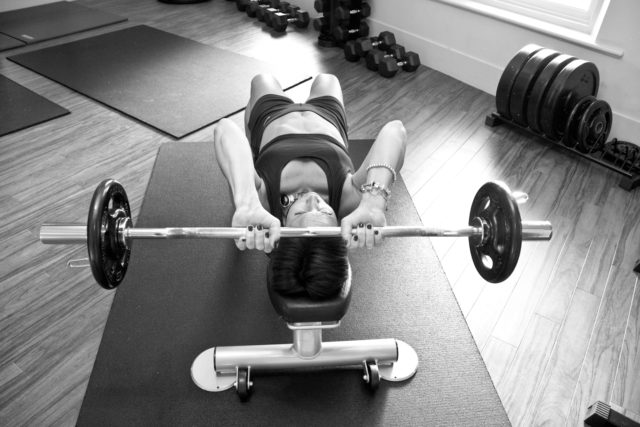What is Resistance Training
Resistance training is defined as “a form of physical activity that is designed to improve muscular fitness by exercising a muscle or muscle group against external resistance” (American College of Sports Medicine).
Why should we do it
This form of exercise is crucial to build and maintain lean muscle mass, such is necessary for the completion of many functional tasks, as well as for sport and recreational activities.
There is also an emerging body of evidence showing that RT appears to be as effective as aerobic exercise in reducing risk of several chronic diseases.
The Benefits to Women
Women who regularly participate in resistance training programs reap numerous physical benefits such as improved muscle definition, strength, body composition, metabolic efficiency, and bone density.
In addition to physiological health, improved psychological and social health also have been positively linked to regular resistance training.
What happens as we age
Lean muscle mass decreases as individuals age and this is linked to many medical conditions and lesser measures of quality of life and/or function. Evidence suggests that skeletal muscle mass and skeletal muscle strength decline in a linear fashion, with up to 50% of mass being lost by the 8th decade of life
Low muscle mass and strength are associated with poor physical function (Visser et al., 2002), and predictive of future mobility impairment in older adults (Visser et al., 2005). Those with low muscle mass and poor physical function have an increased chance of being physically dependent as they age.
Women generally have a lower proportion of type II (i.e. fast power-producing) muscle fibres than men, and loss of these muscles fibres becomes pronounced during the menopause transition as hormonal changes accelerate the loss of lean muscle mass.
Research has shown that even just six months of heavy resistance training improves bone mineral density of the femoral neck and lumbar vertebrae in premenopausal women.
Weighted exercises can help in maintaining bone density in postmenopausal women and increasing BD of the spine and hip in women with osteopenia and osteoporosis
A study on postmenopausal women who did back strengthening exercises for two years showed that their risk for spinal compression fractures was 2.7 times lower than their peers who did not.
And another study showed high-intensity resistance and plyometric training improved markers of bone strength in postmenopausal women with low to very low bone mass with no adverse affects.
So, for women working with weights to build and maintain as much strength, power, and force is especially important.
Why do women shy away from training with weights?
Research indicates that research shows that only 20% of women participate in regular RT exercise.
There are several possible explanations for this
- A general tendency of many women to spend most of their exercise time doing cardiovascular exercise, perhaps believing that this results in more benefits to health and/or body appearance.
- A fear of the perceived “masculine” areas in the gym
- Concerns that they will “bulk up”
- Not knowing what to do
- Fear of injury
Grip Strength
‘Grip strength is the force applied by the hand to pull on or suspend from objects and is a specific part of hand strength’.
The handgrip strength reflects a variety of physical function indices and is therefore regarded as an important indicator of health-related quality of life of older adults.
A strong grip at an older age is an indicator of longevity, and the stronger your grip, the more likely you are to survive diseases like cancer.
As well as being a predictor of your overall strength and health, grip strength indicates risk of cardiovascular disease.
A weak handgrip strength is also associated with hypertension, coronary heart disease, peripheral arterial disease, heart failure, stroke, or chronic obstructive pulmonary disease
RT will help to improve grip strength due to the need to hold items, push and pull.
How do I do it and how often
Resistance training can be performed using equipment like free weights, weight machines, weighted balls, resistance bands, body weight resistance equipment (suspension trainers) and bodyweight.
The ACSM recommends that RT be performed at least twice per week, with 8–12 repetitions of 8–10 exercises targeting all major muscle groups to maintain the health of the musculoskeletal system through the lifespan.
Conclusion
As we age, it’s especially important to focus on building and maintaining muscle mass. This helps reduce the risk of many diseases as well as physical injury. A structured strength-training program can help you improve overall muscle strength and physical fitness.
That said multicomponent exercise programs consisting of RT, aerobic exercise, and balance training in combination appear to be the best strategy for attenuating declines in physical mobility
If you are unsure of how to start on a resistance training program, contact a good personal trainer who will help you get started safely.

Rachel Law is a personal fitness trainer based in New Malden, Surrey. Qualifications: ActivIQ Level 3 Personal Training; Burrell Education Pregnancy Exercise Prescription; Burrell Education Advanced Pregnancy Wellness Practitioner; Burrell Education Advanced Post Natal Exercise Prescription; Burrell Education 3rd Age Women Optimal Health and Nutrition; Burrell Education Peri Natal Athlete; Burrell Education Pelvic Flow and Freedom; Olympic Weight Lifting; Premier Global Kettlebells; FIE Level Assessment and Mentoring


